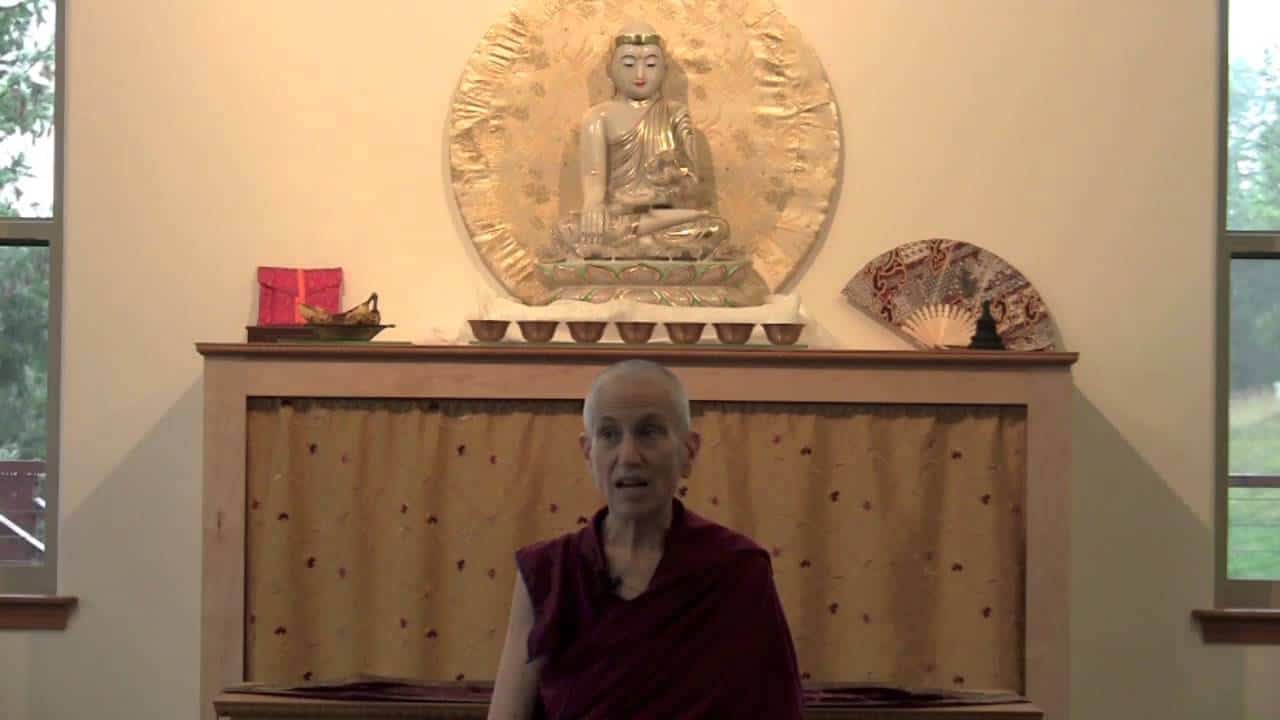The three types of fortitude
The text turns to training the mind on the stages of the path of advanced level practitioners. Part of a series of teachings on the Gomchen Lamrim by Gomchen Ngawang Drakpa. Visit Gomchen Lamrim Study Guide for a full list of contemplation points for the series.
- How self-centered thought is the robber that steals our happiness
- Review of the definition of fortitude
- The fortitude of non-retaliation
- How to endure physical and mental suffering
- Inner strength when practicing the Dharma
Gomchen Lamrim 106: The Three Types of Fortitude (download)
Contemplation points
- Venerable Chodron said she uses the word fortitude because it doesn’t imply the same passive tone as patience. Fortitude is active. It’s internal strength. Think about the definition: an undisturbed mind that can bear harm inflicted by others, suffering, and difficulties that we encounter to practice. How have you seen fortitude operate in your own life? In the world? What makes fortitude a virtue? In other words, why is this a quality you’d like to cultivate in your own life?
- The first type of fortitude is fortitude of non-retaliation.
- Were you taught as a child that when others harm, you’re entitled to harm them back? How do you see this philosophy operate in our world? How do you see it operate in your own life?
- This type of fortitude is more than just buckling down and bearing others’ abuse. It’s not about stuffing our anger down, pretending it’s not there, and being the world’s doormat. It’s actually processing your experience in a very different way. What tools does the Dharma give you to overcome anger and process your experience in a way that is more realistic and beneficial?
- Cultivating wisdom takes practice. Often, we’re so convinced that the story-line we’re telling ourselves is 100% true that it feels like we’re white-washing our experience if we try to think of it in another way. What is your experience? Have you felt like you were white-washing? Have there been times when you were convinced you were right and once the anger subsided, you were able to see things differently? How can this awareness better prepare you for the next time you are overwhelmed with an affliction? How might practice seeing things in different ways be of benefit?
- The second type of fortitude is the fortitude of enduring suffering such as illness, injury, etc.
- Think of times where you were sick or injured and rejected the experience, getting angry at yourself or others. What are the disadvantages of not using the thought training techniques?
- Venerable Chodron suggested a number of techniques for working with illness and injury (i.e. seeing it as an opportunity to practice, seeing it as a ripening of karma, taking and giving meditation, etc). Have you employed any of these in the past? What was the result?
- How might the fortitude of enduring suffering benefit you? How might it benefit others around you? How might it benefit the world?
- The third type of fortitude is the fortitude to practice the Dharma.
- What are some different kinds of suffering that come up for you in practicing the Dharma?
- What tools do the teachings provide to help you overcome suffering that leads to this kind of fortitude. Have you employed any of these in the past? What were the results?
- Resolve to cultivate internal strength in your life by being mindful of your own anger and applying the appropriate antidotes. Start with small experiences of upset, disappointment, illness, etc. Be sure to rejoice each time you recognize fortitude in your life or in the world around you.
Venerable Thubten Chodron
Venerable Chodron emphasizes the practical application of Buddha’s teachings in our daily lives and is especially skilled at explaining them in ways easily understood and practiced by Westerners. She is well known for her warm, humorous, and lucid teachings. She was ordained as a Buddhist nun in 1977 by Kyabje Ling Rinpoche in Dharamsala, India, and in 1986 she received bhikshuni (full) ordination in Taiwan. Read her full bio.


